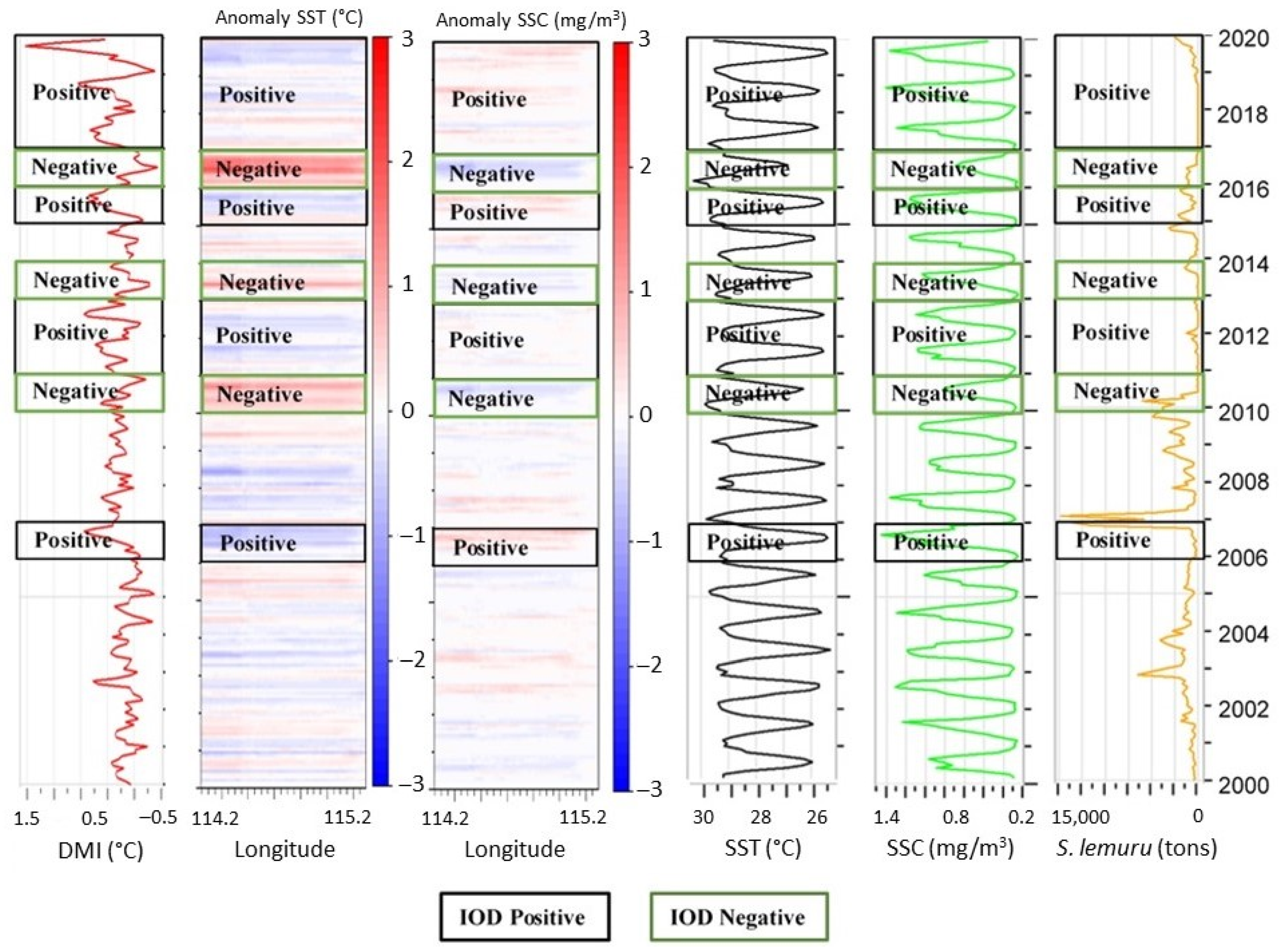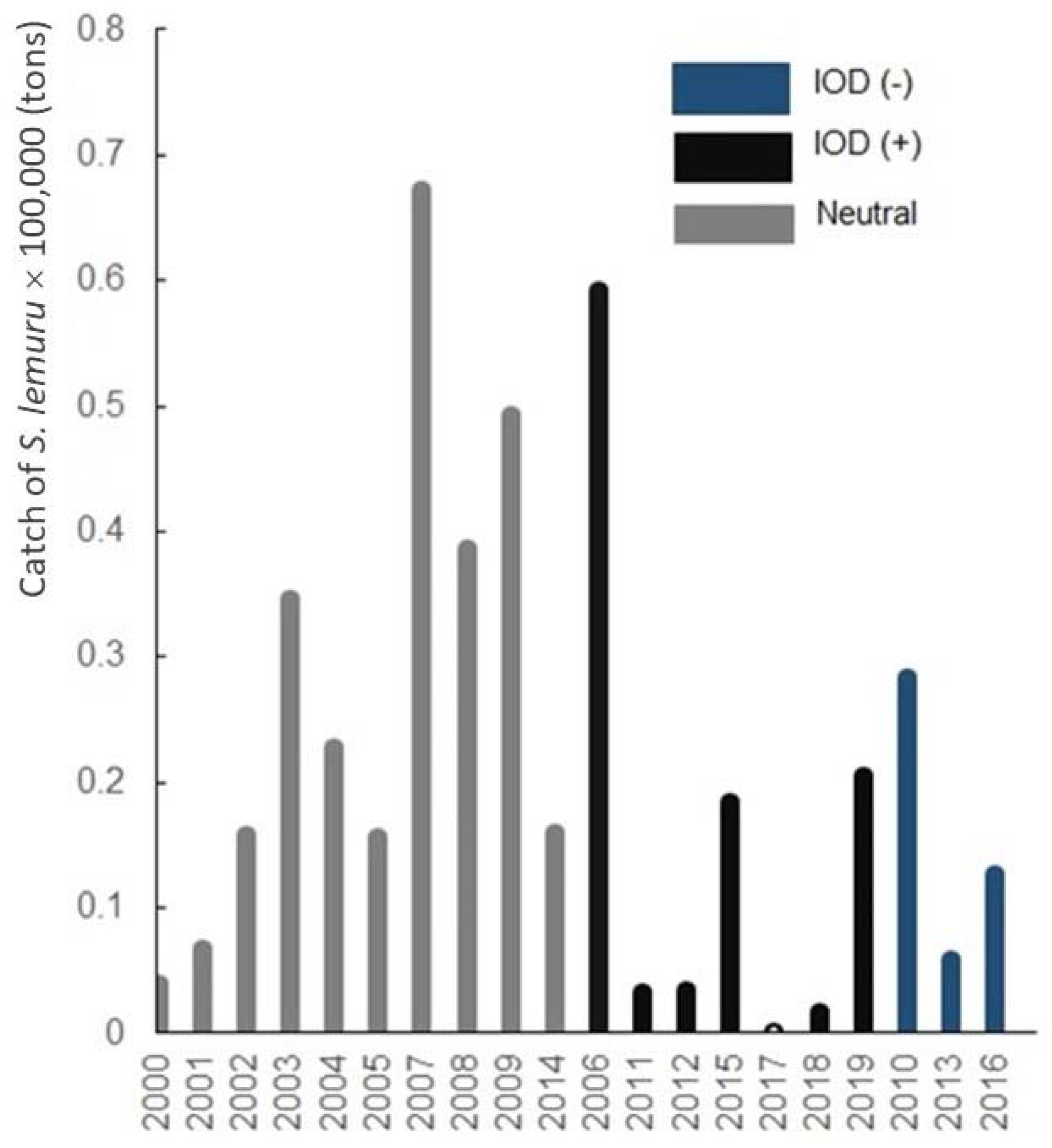Upwelling Impact on Sardinella lemuru during the Indian Ocean Dipole in the Bali Strait, Indonesia
Abstract
:1. Introduction
2. Results
2.1. Variability of Sea Surface Temperature (SST) and Sea Surface Chlorophyll (SSC)
2.2. Comparison of Sardinella lemuru Catch with the IOD Phase
3. Discussion
4. Materials and Methods
5. Conclusions
Author Contributions
Funding
Institutional Review Board Statement
Informed Consent Statement
Data Availability Statement
Acknowledgments
Conflicts of Interest
References
- Saji, N.H.; Goswami, B.N.; Vinayachandran, P.N.; Yamagata, T. A dipole mode in the tropical Indian Ocean. Nature 1999, 401, 360–363. [Google Scholar] [CrossRef]
- Webster, P.J.; Moore, A.M.; Loschnigg, J.P.; Leben, R.R. Coupled ocean-temperature dynamics in the Indian Ocean during 1997-98. Nature 1999, 401, 356–360. [Google Scholar] [CrossRef]
- Murtugudde, R.; McCreary, J.P.; Busalacchi, A.J. Oceanic processes associated with anomalous events in the Indian Ocean with relevance to 1997-98. J. Geophys. Res. 2000, 105, 3295–3306. [Google Scholar] [CrossRef] [Green Version]
- Susanto, R.D.; Marra, J. Chlorophyll-a Variability Along the Southern Coasts of Java and Sumatra. Oceanography 2005, 18, 663–671. [Google Scholar] [CrossRef]
- Iskandar, I.; Rao, S.A.; Tozuka, T. Chlorophyll- a bloom along the Southern Coasts of Java and Sumatra during 2006. Int. J. Remote Sens. 2009, 30, 663–671. [Google Scholar] [CrossRef] [Green Version]
- Horii, T.; Ueki, I.; Ando, K.; Mizuno, K. Eastern Indian Ocean warming associated with the negative Indian Ocean dipole: A case study of the 2010 event. J. Geophys. Res. Oceans 2013, 118, 536–549. [Google Scholar] [CrossRef]
- Sartimbul, A.; Nakata, H.; Rohadi, E.; Yusuf, B.; Kadarisman, H.P. Variations in chlorophyll-a concentration and the impact on Sardinella lemuru catches in Bali Strait, Indonesia. Prog. Oceanogr. 2010, 87, 168–174. [Google Scholar] [CrossRef]
- Berlianty, D.; Yanagi, T. Tide and Tidal Current in the Bali Strait, Indonesia. Mar. Res. Indones. 2011, 36, 25–36. [Google Scholar] [CrossRef]
- Wijaya, A.; Zakiyah, U.; Sambah, A.B.; Setyohadi, D. Spatio-temporal variability of temperature and chlorophyll-a concentration of sea surface in Bali Strait, Indonesia. Biodiversitas 2020, 21, 5283–5290. [Google Scholar] [CrossRef]
- Sukresno, B.; Jatisworo, D.; Kusuma, D.W. Multilayer Analysis of Upwelling Variability in Southern Java Waters. J. Kelaut. Nas. 2018, 13, 15–25. [Google Scholar] [CrossRef]
- Lumban-Gaol, J.; Wudianto, B.P.; Pasaribu, D.; Manurung, E.R. The Fluctuation of Chlorophyll-a Concentration Derived from Satellite Imagery and Catch of Oily Sardine (Sardinella lemuru) in Bali Strait. Remote Sens. Earth Sci. 2014, 1, 24–30. [Google Scholar] [CrossRef] [Green Version]
- Ningsih, N.S.; Rakhmaputeri, N.; Harto, A.B. Upwelling Variability along the Southern Coast of Bali and in Nusa Tenggara Waters. Ocean Sci. J. 2013, 48, 49–57. [Google Scholar] [CrossRef]
- Susanto, R.D.; Gordon, A.L.; Zheng, Q. Upwelling along the coasts of Java and Sumatra and its relation to ENSO. Geophys. Res. Lett. 2001, 28, 1559–1602. [Google Scholar] [CrossRef]
- Susanto, R.D.; Moore, T.S.I.I.; Marra, J. Ocean Color Variability in the Indonesian Seas during the SeaWiFS Era. Geochem. Geophys. Geosyst. 2006, 7, 1–16. [Google Scholar] [CrossRef]
- Hendiarti, N.; Siegel, H.; Ohde, T. Investigation of Different Coastal Processes in Indonesian Waters Using SeaWiFS Data. Deep-Sea Res. Part II Top. Stud. Oceanogr. 2004, 51, 85–97. [Google Scholar] [CrossRef]
- Qu, T.; Du, Y.; Strachan, J.; Meyers, G.; Slingo, J. Sea Surface Temperature and its Variability in the Indonesian Region. Oceanography 2005, 18, 50–61. [Google Scholar] [CrossRef] [Green Version]
- Sambah, A.B.; Miura, F.; Kadarisman, H.P.; Sartimbul, A. Remote Sensing Application for Sardinella lemuru Assessment: A Case Study of the South Waters of Malang Regency, East Java, Indonesia. Remote Sens. Mar. Environ. 2012, 85250. [Google Scholar] [CrossRef]
- Wyrtki, K. The upwelling in the region between Java and Australia during the southeast monsoon. Mar. Freshw. Res. 1962, 13, 217–225. [Google Scholar] [CrossRef]
- Iskandar, I.; Lestari, D.O.; Utari, P.A.; Khakim, M.Y.N.; Poerwono, P.; Setiabudidaya, D. Evolution and impact of the 2016 negative Indian Ocean Dipole. J. Phys. Conf. Ser. 2018, 985, 012017. [Google Scholar] [CrossRef] [Green Version]
- Siswanto, E.; Horii, T.; Iskandar, I.; Gaol, J.L.; Setiawan, R.Y.; Susanto, R.D. Impacts of climate changes on the phytoplankton biomass of the Indonesian Maritime Continent. J. Mar. Syst. 2020, 212, 103451. [Google Scholar] [CrossRef]
- Matsuyama, M.; Senjyu, T.; Natih, N.M.N. Oceanographic conditions in Pelabuhanratu Bay, West Java. Lamer 1996, 34, 283–291. [Google Scholar]
- Du, Y.; Cai, W.; Wu, Y. A new type of the Indian Ocean Dipole since the mid-1970s. J. Clim. 2013, 28, 959–972. [Google Scholar] [CrossRef]
- Sari, Q.W.; Utari, P.A.; Setiabudidaya, D.; Yustian, I.; Siswanto, E.; Iskandar, I. Surface chlorophyll-a variations in the Southeastern Tropical Indian Ocean during various types of the positive Indian Ocean Dipole events. Int. J. Remote Sens. 2019. [Google Scholar] [CrossRef]
- Lumban-Gaol, J.; Leben, R.R.; Vignudelli, S.; Mahapatra, K.; Okada, Y.; Nababan, B.; Mei-Ling, M.; Amri, K.; Arhatin, R.E.; Syahdan, M. Variability of satellite-derived sea surface height anomaly, and its relationship with Bigeye tuna (Thunnus obesus) catch in the Eastern Indian Ocean. Eur. J. Remote Sens. 2015, 48, 465–477. [Google Scholar] [CrossRef]
- Matsuura, H.; Sugimoto, T.; Nakai, M.; Tsuji, S. Oceanographic conditions near the spawning ground of southern bluefin tuna; northeastern Indian Ocean. J. Oceanogr. 1997, 53, 421–434. [Google Scholar]
- Dahl, R.E.; Oglend, A. Fish price volatility. Mar. Resour. Econ. 2014, 29, 305–322. [Google Scholar] [CrossRef]
- Sathiadhas, R.; Narayanakumar, R. Price policy and fish marketing system in India. J. Biol. Educ. 1994, 11, 225–241. [Google Scholar]
- Pet, J.S.; Van Densen, W.L.T.; Machiels, M.A.M.; Sukkel, M.; Setyohadi, D.; Tumuljadi, A. Length-based analysis of population dynamics and stock identification in the sardine fisheries around East Java, Indonesia. Fish. Res. 1997, 31, 107–120. [Google Scholar] [CrossRef]
- Kunarso; Ningsih, N.S.; Supangat, A. Characteristics of Upwelling along the Waters of Southern NTT to West Sumatra. J. Ilmu Kelaut. 2005, 10, 17–28. [Google Scholar] [CrossRef]





Publisher’s Note: MDPI stays neutral with regard to jurisdictional claims in published maps and institutional affiliations. |
© 2021 by the authors. Licensee MDPI, Basel, Switzerland. This article is an open access article distributed under the terms and conditions of the Creative Commons Attribution (CC BY) license (http://creativecommons.org/licenses/by/4.0/).
Share and Cite
Setyohadi, D.; Zakiyah, U.; Sambah, A.B.; Wijaya, A. Upwelling Impact on Sardinella lemuru during the Indian Ocean Dipole in the Bali Strait, Indonesia. Fishes 2021, 6, 8. https://0-doi-org.brum.beds.ac.uk/10.3390/fishes6010008
Setyohadi D, Zakiyah U, Sambah AB, Wijaya A. Upwelling Impact on Sardinella lemuru during the Indian Ocean Dipole in the Bali Strait, Indonesia. Fishes. 2021; 6(1):8. https://0-doi-org.brum.beds.ac.uk/10.3390/fishes6010008
Chicago/Turabian StyleSetyohadi, Daduk, Umi Zakiyah, Abu Bakar Sambah, and Adi Wijaya. 2021. "Upwelling Impact on Sardinella lemuru during the Indian Ocean Dipole in the Bali Strait, Indonesia" Fishes 6, no. 1: 8. https://0-doi-org.brum.beds.ac.uk/10.3390/fishes6010008





